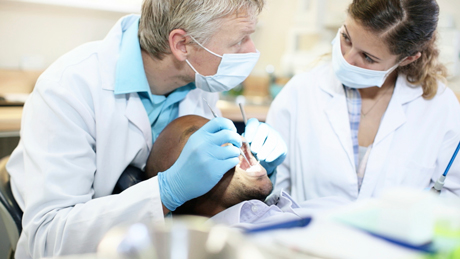What Does It Take to Become a Dentist?

Dentists often say the best part of their job is their ability to improve peoples’ smiles through excellent care, skill, and judgment. Many patients don’t realize the amount of training, education, and dedication that has gone into the dentist’s career choice.

The path to becoming a dentist starts in high school. It is important to take Advanced Placement science classes to lay a good foundation for college science coursework. Students should consider picking up a hobby or area of study (such as sculpture or playing an instrument) that develops their manual dexterity. It is also a good idea to start shadowing a dentist if possible to make sure that a career in dentistry is the right fit.
In college, pre-dental students must complete a variety of science courses (such as genetics, cell biology, microbiology, general chemistry, organic chemistry, and physics) that cover the basic principles for what will be covered in dental school. In order to be a competitive dental school applicant, students should strive to earn A’s in these courses. Pre-dental students must take the Dental Aptitude Test (DAT) which has sections in Biology, General Chemistry, Organic Chemistry, Perceptual Ability Testing, Reading Comprehension, and Quantitative Reasoning. Finally, dental schools recommend applicants complete at least one hundred hours of both dental shadowing and community service. The more an applicant can do to stand out, the better.
Pre-dental students should apply to dental school the summer going into their senior year, or the summer after graduating if they have chosen to take a gap year. Once dental school administrators receive an applicant’s information via the ADEA AADSAS common application, they will decide whether not to send the applicant an interview invite. After interviews, dental schools then decide which students will make up their incoming class. Most dental classes have around one hundred students and there are sixty-five dental schools in the U.S.
Once accepted to dental school, students must complete a four-year course of study before they can graduate with a Doctorate of Dental Surgery or Doctorate of Dental Medicine. The first year of dental school consists of challenging lectures and coursework in dental anatomy, dental materials, preventive dentistry, and additional dental and medical courses. Students need to perform well to advance to the second year of dentistry, which consists of more dental lab work on simulation materials. After the second year of dental school, students must pass the first part of the National Boards to demonstrate their cumulative knowledge of dentistry.
 The third year of dental school is when dental students begin treating patients and spend less time in lectures. Students begin with restorations and simple procedures under strict supervision and guidance from professors. The final year of dental school is almost entirely patient work and students further develop their clinical skills. After completing four years of dental school, students must pass the second part of the National Boards, which involves procedural work on a real patient. Upon graduating and passing the National Board, dental students are officially recognized as general dentists and can earn the right to practice in the state of their choice by passing that state’s dental boards.
The third year of dental school is when dental students begin treating patients and spend less time in lectures. Students begin with restorations and simple procedures under strict supervision and guidance from professors. The final year of dental school is almost entirely patient work and students further develop their clinical skills. After completing four years of dental school, students must pass the second part of the National Boards, which involves procedural work on a real patient. Upon graduating and passing the National Board, dental students are officially recognized as general dentists and can earn the right to practice in the state of their choice by passing that state’s dental boards.
Once they’ve passed all of the boards, graduates can begin practicing immediately or choose to complete an Advanced Education in General Dentistry or a General Practice Residency to further develop their clinical skills. Other dentists choose to become specialists in a specific field of dentistry, and complete an additional two-to-six years of education and training in endodontics, pediatric dentistry, prosthodontics, periodontics, orthodontics, or oral and maxillofacial surgery. Dental specialists must pass the respective National Board for their area of expertise before they are allowed to practice in that field.
All of the education and training is rewarded by the smiles of their patients. Dentists combine their knowledge of artistry and science to create strong, healthy teeth and restorations that will allow their patients to lead fuller lives. With a complete set of teeth, patients can smile, speak, and chew easily. Our dentists take pride in the experience they bring to help their patients restore their smiles and their self-confidence.
Posted by John Doe

Lorem ipsum dolor sit amet, consectetur adipisicing elit. Dolores, eveniet, eligendi et nobis neque minus mollitia sit repudiandae ad repellendus recusandae blanditiis praesentium vitae ab sint earum voluptate velit beatae alias fugit accusantium laboriosam nisi reiciendis deleniti tenetur molestiae maxime id quaerat consequatur fugiat aliquam laborum nam aliquid. Consectetur, perferendis?